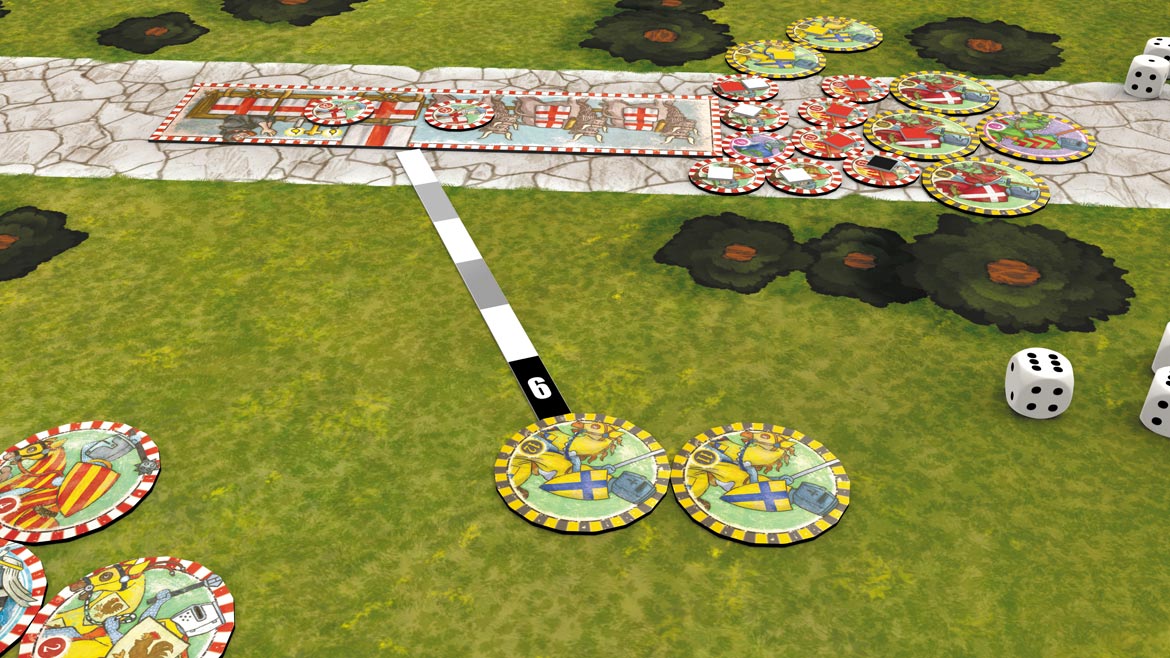Move, move, move!
With July 7, 2020 (launch date of our Kickstarter campaign to publish The Fall of the King™) approaching, we continue our analysis of the Ventura Battle System™’s main features for everyone interested in the new Sir Chester Cobblepot wargame. We strongly recommend you also read the previous articles to fully understand the topic at hand.
Choosing your Action
Once you understand the importance of components, tiles and cards, in order to play with the Ventura Battle System™ you will need to learn the mechanics of Actions. After activating one of your piles, you must declare which Action you want that Soldier, Group or Formation to perform. After declaring, the player must verify the feasibility of the Action through measurements.
Short actions
There are only two types of Actions: Short and Long. You can perform up to two Short Actions in the same turn, while only one Long Action can be performed in the same turn. There are six Short Actions in the rules for playing the Historical Scenarios of The Fall of the King™: March, Bypass, Shoot, Reload, Mount/Dismount, and Interact.
Long actions
The Long Actions for The Fall of the King™'s Scenarios are also six: Run, Cross, Aim, Attack, Confront and Capture. In both cases, Formations require an additional marker expense (of any color, blue for the Condottiere or purple for the Constable): +1 for Short Actions and +2 for Long Actions. You can find each Action's description in a reference table on the last page of the Rulebook, so that you won't have to constantly flip through it.
Complex actions
Regardless of their “duration” (Short or Long), Actions can also be Complex, which means that an additional expense of any +1 marker is required. The expenditure in markers to make Formations perform Actions must always be sustained by your Constable (who must be part of the Formation) or by your Condottiere.
Spending markers
You can also pay the marker costs by combining markers of both colors from both Commanders. However, if the Condottiere is leading the Formation, then marker costs for Actions must be fully covered by him. The consequences of Actions can lead to changes in piles, which must be suitably and constantly adjusted at the end of each turn.
Check on your opponent
Each player must watch over every detail during the opponent's turn, because a mistake, even in good faith, risks having a deep effect on the battle. When already-activated cards become part of a pile, the entire pile is activated immediately and completely: no pile can ever have only some activated cards.
Move the Soldiers
Marching, Running and Attacking, but also Bypassing and Crossing, are all Actions that allow players to move (according to March or Run values) their Soldiers. Movements are performed by placing rulers next to the Soldier's tile, without moving it and where space allows. You can move in a straight line in any direction while respecting the space available on the battlefield at that time.
Use the ruler correctly
The ruler must not touch any other tile (both friendly or enemy) or obstacles created by terrain elements, such as Trees or the Low Wall of the 4th Scenario. After moving the Soldier tile you took the measurement from, you can remove the ruler and move the other Soldiers in the pile, changing their position as long as they remain in contact with each other.
Combining and splitting the piles
It is not mandatory to move all the Soldiers of the pile that has been activated: in that case, the pile must be immediately adjusted accordingly. A movement that ends with a tile coming into contact with friendly Soldiers from other piles can create new Groups or Formations: in this case, too, the piles must be immediately adjusted accordingly.

